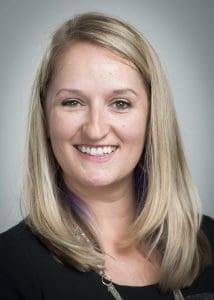Kelly Farquharson, Professor in FSU’s School of Communication Science and Disorders (SCSD), has published a longitudinal study in collaboration with Tiffany P. Hogan and Jordan R. Green, both from MGH Institute of Health Professions in Boston, Massachusetts.
The study follows nine infants from English-speaking US families between the ages of 9 and 30 months. They recorded each infant’s babble as the child interacted with their primary caregiver, looking specifically at the consonant-vowel ratio. The authors then met each child again when they were six years old to examine their ability to identify letters, a known predictor of later reading impairment. You can read the full study by clicking here.
As for the results, they found that those children with more complex babble as infants performed better when identifying specific letters in their later reading test. These results may indicate a link between early speech production and literacy skill. “I am really proud of this publication.” Farquharson says, “I think there are several important next steps for this work. The first and immediate steps are for parents to be aware of the importance of speech development. Speech development contributes to many later skills, including vocabulary and word reading; now we know it also has connections to letter knowledge. Parents should consistently and regularly talk to and read to their children – these are the best ways to provide rich language experiences.”
 “Our results support that a child’s speech development over time is related to later letter knowledge.” Farquharson continues, “For researchers, we clearly need a larger and more diverse sample that examines additional child-level factors and environmental-level factors (like the family’s socioeconomic status or if the child attends daycare or preschool) to continue to understand the relation between early speech production and later letter knowledge. Such a study may be robust and powerful enough to impact legislation and to further impact clinical practice.”
“Our results support that a child’s speech development over time is related to later letter knowledge.” Farquharson continues, “For researchers, we clearly need a larger and more diverse sample that examines additional child-level factors and environmental-level factors (like the family’s socioeconomic status or if the child attends daycare or preschool) to continue to understand the relation between early speech production and later letter knowledge. Such a study may be robust and powerful enough to impact legislation and to further impact clinical practice.”
Reflecting on the experience of concluding a six year long study Farquharson says, “I’m so honored to have been a part of this research team. The idea for this study was born when I was a doctoral student at the University of Nebraska-Lincoln. I just so happened to be lucky enough to have a supportive mentor in Dr. Tiffany Hogan and a generous collaborator in Dr. Jordan Green. Dr. Green is the primary investigator for the larger study and was open and willing to sharing his data for this purpose. Dr. Lesa Hoffman taught me how to run the statistical analysis and then provided loads of support in making this type of complex analysis palatable. Kimber Green spent countless hours teaching me the coding scheme for these data. Dr. Jun Wang was a doctoral student with me at UNL and wrote the Matlab code that made data processing possible. I’m so thankful that this team was able to bring an important idea to life.”
You can watch the short Youtube video from Buzz60 that summarizes the study, read the write-up on Science Direct, or check out the Open Access publication.

